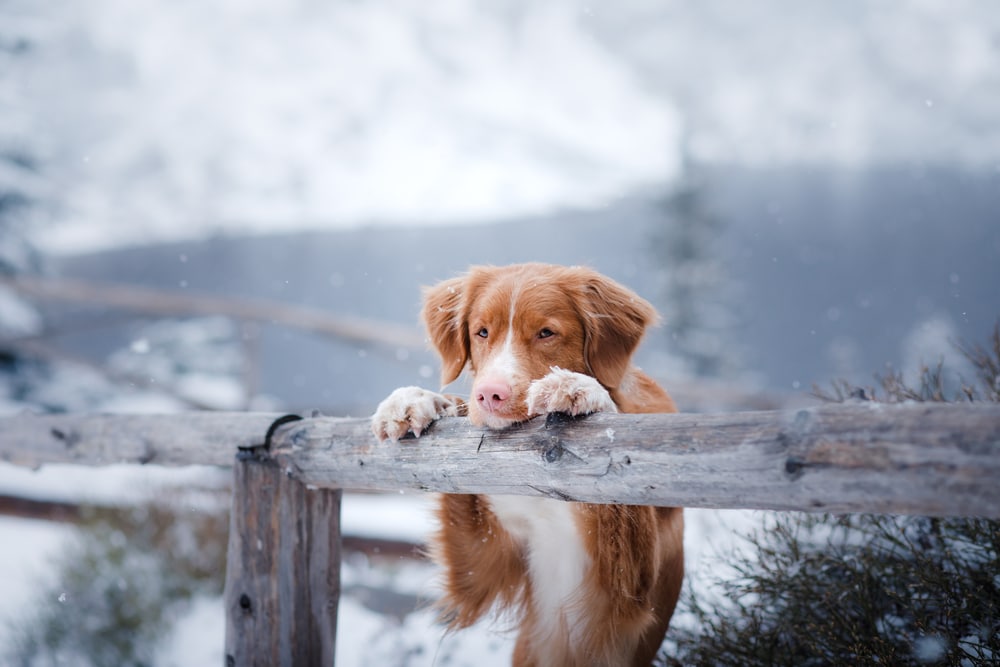Dogs are just as susceptible to cold weather as we are, and they can experience great discomfort if left exposed to colder climates. They have thick fur and a coat of hair that helps insulate them from the cold. But when temperatures drop below freezing, their natural insulation isn’t enough to keep them warm. So, what are the signs a dog is cold?
When our furry friend is feeling the chill, there are several warning signs to look for. Common signs of being too cold include shivering, trembling, whining or barking excessively, appearing anxious or uncomfortable, hiding in smaller areas like under tables or beds, curling up into a tight ball-like position when sleeping, and lowering their activity levels.
Table of Contents
What Are The Signs My Dog Is Too Cold?
Pet owners need to be aware of the signs of cold weather discomfort in their pets. Cold temperatures can be dangerous and lead to hypothermia. If your dog is exhibiting any of the following signs, it may be time to bring them inside or provide additional protection from the cold.
Shivering And Trembling
Shivering and trembling are some of the most common signs your pup is too cold. Dogs get cold, just like people. If you notice your dog shaking or shivering, it’s time to take them indoors or provide them with additional warmth. Dogs have fur coats for insulation, but if temperatures drop below freezing, their natural protection may not be enough to keep them warm.
Shivering is an involuntary response in which a dog’s muscles contract to generate heat and stay warm. This usually intensifies if they are exposed to cold temperatures for prolonged periods of time.
Excessive Barking Or Whining
Excessive barking and whining can be an indication that your pup is feeling the chill. If you notice your dog making more noise than usual, it could be due to feeling uneasy about the cold weather. Dogs are typically more vocal when they’re cold and may bark and whine if they are too uncomfortable in the cold weather.
They may also bark out of frustration if they are trying to keep warm but can’t get comfortable. This could be a sign of distress and should not be ignored. Because it can lead to further health issues if left unchecked. So, pay proper attention to their vocalizations.
Anxiety And Discomfort
If your pup feels too cold, it may appear anxious or uncomfortable. It may be pacing around more than usual or avoiding activities that would normally interest it, like going for walks and playing. If you notice behavior changes in your dog that are out of the norm, it could be due to the cold weather.
Hiding In Smaller Areas
Dogs instinctively seek out smaller areas as protection from cold temperatures and will try to stay close to heat sources like radiators or fireplaces. If you notice your pup trying to fit into tight spots, such as under furniture or bedding, provide them with additional warmth and keep an eye on their behavior.
Curling Up in a Ball-Like Position
When a dog curls up in a ball-like position when sleeping, it is its way of conserving precious body heat. This instinctive behavior reduces the amount of exposed skin and keeps the most important internal organs warmer for longer. It can be seen as a sign your pup is feeling too cold and needs additional warmth or shelter.
Lowering Activity Levels
A decrease in activity levels can also be an indication your pup is feeling cold. Doggies typically become less energetic when they are too cold as their bodies need to conserve energy to stay warm.
If your pup is not playing, running around, or showing any enthusiasm when outside, it’s time to head back inside and make sure they bundle up and beat the chill!
Additional Signs Showing A Dog Is Too Cold
Some symptoms may signify your pup is too cold. Your vet can confirm the diagnosis and recommend treatment to help alleviate your pet’s symptoms. Additionally, if you notice any unusual or alarming behaviors in your dog, always contact a vet for advice and an examination.
Here are some of the most common symptoms that may suggest your pup is feeling cold.
- Sneezing
- Coughing
- Nasal congestion
- Watery eyes
- A runny nose
- Body aches
- Sore throat
- Fever
How Does Cold Weather Affect Dogs?
Cold weather can have a significant impact on your pup’s health, as extreme temperatures can lead to severe illnesses and conditions. Here, we look at the most common adverse effects of cold weather on dogs.
Limited Mobility
When temperatures drop, a dog’s muscles can start to stiffen and make movement difficult. This can be particularly dangerous for senior dogs or those with mobility issues, as they may not be able to move freely in the cold. Cold weather also affects joints and bones, making it more difficult for your pup to stay active outside.
Susceptibility To Hypothermia
Hypothermia is a life-threatening condition that can occur when your pup’s body temperature drops below normal levels due to extreme exposure to cold temperatures. Symptoms include shivering, weakness, lethargy, pale gums, and in some cases, unconsciousness.
Frostbite Risks
Once the temperature dips below freezing, 32 degrees Fahrenheit (zero degrees Celsius) or lower, dogs become vulnerable to frostbite. It occurs when the skin and fur become frozen, leading to painful lesions or even tissue damage in severe cases.
Dogs with short fur or those not adequately dressed are most at risk of developing this condition. If you notice any signs of frostbite on your pup, take them to the vet immediately for treatment.
Altered Metabolism
When dogs are subjected to cold temperatures, their metabolism alters to generate more heat. This extra calorie expenditure can lead to weight loss if not managed carefully. If your pup is exposed to cold weather for long periods, it may be necessary to slightly increase its caloric intake to maintain a healthy body weight.
Cold Weather Safety Tips for Dogs

Are you concerned about keeping your beloved pup safe during cold weather? Here are some tips for keeping your pup safe and comfortable when temperatures drop.
Provide Adequate Shelter
Provide adequate shelter during cold weather to your doggies. Make sure they have a warm and dry place to sleep, such as a dog house that is insulated, elevated off the ground, and has a waterproof roof.
Bundle Up
Invest in a warm coat, sweater, or booties for those extremely cold days. This can help protect your pup from the elements.
Keep Fur Clean And Dry
Wipe your pup’s paws and stomach after they come inside from playing in the snow to prevent them from getting too cold. Also, make sure their fur is not matted or wet so that it can still provide insulation against the cold.
Limit Outdoor Time
Limit your dog’s outdoor activities to just a few minutes at a time during the colder months. This will help keep them warm and reduce their risk of getting too cold.
Provide More Food And Water
Dogs burn more calories in the winter, trying to keep warm. Provide them with plenty of fresh water and a well-balanced diet.
In Conclusion: Signs A Dog Is Cold
Cold weather is often a cause of discomfort for dogs and can lead to serious health issues if left unchecked. It’s important to pay close attention to your pup during cold weather and ensure they are adequately dressed, sheltered from the elements, and given enough warmth to stay comfortable.
If you see your pup showing any of these signs of being too cold, take immediate action to make them more comfortable and consult with your veterinarian.
So, have you noticed any additional signs or symptoms when your dog gets cold? What do you do to keep them safe and warm from the cold? Let us know in the comments below!
